December 9, 2022
Air Date: December 9, 2022
FULL SHOW
SEGMENTS

A Treaty to Fight Plastic Waste
View the page for this story
In March, delegates at the UN Environment Program committed to creating a legally binding agreement to tackle the plastic crisis all the way from production to disposal – its full “life cycle”. And the first of five negotiating meetings, which will eventually produce a treaty document, recently wrapped up in Uruguay. Margaret Spring, the Chief Conservation and Science officer at the Monterey Bay Aquarium, attended the negotiations and joins Host Bobby Bascomb to discuss progress made and the presence of the plastics industry at the talks. (10:29)
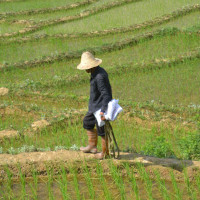
Beyond the Headlines
/ Peter DykstraView the page for this story
In this week’s trip beyond the headlines, Environmental Health News editor Peter Dykstra and Host Steve Curwood discuss the results of the Georgia runoff election and its implications for environmental policy. Next, they touch on fertilizer and pesticide reductions in China and controversial state-sanctioned wolf hunting in Montana. Finally, they go back in time to remember the 55-mph federal speed limit. (04:22)
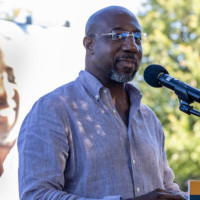
Green Voters Help Democrats
View the page for this story
Democrats outperformed expectations during the midterm elections that concluded December 5th with Georgia Senator Raphael Warnock’s reelection in a runoff. Nathaniel Stinnett, founder and executive director of the Environmental Voter Project, joins Host Steve Curwood to take a look at the impact of environmentally focused voters at the ballot box during the midterm election season. (13:29)
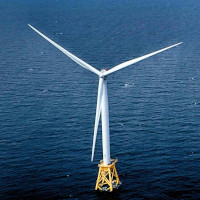
Bipartisan Support for Offshore Wind
View the page for this story
The Biden Administration is moving forward with plans for auctioning offshore wind energy areas, most recently in the Gulf of Mexico. Meanwhile in Congress, there is a bipartisan effort called the Breeze Act that would update offshore revenue sharing rules that date back to the early days of oil and gas production. Democratic Congressman Troy Carter joins Host Steve Curwood to discuss his collaboration on the legislation with fellow Louisiana Congressman Steve Scalise, the number two House Republican leader, and what the new offshore wind energy areas in the Gulf mean for Louisiana and Texas. (10:18)

Ancient Stories of Sea Level Rise
View the page for this story
The seas are rising because of climate change, but this isn’t the first global sea level rise humans have lived through. In fact, some Indigenous peoples have stories of sea level rise that they’ve passed down over thousands of years. Patrick Nunn, a geographer and geologist at the University of the Sunshine Coast in Australia, joins Host Bobby Bascomb to tell us about how oral traditions reflect the environmental changes our ancestors lived through. (08:53)
Show Credits and Funders
Show Transcript
221209 Transcript
HOSTS: Steve Curwood
GUESTS: Troy Carter, Patrick Nunn, Margaret Spring, Nathaniel Stinnett
REPORTERS: Peter Dykstra
[THEME]
CURWOOD: From PRX – this is Living On Earth.
[THEME]
CURWOOD: I’m Steve Curwood.
BASCOMB: And I’m Bobby Bascomb
Delegates from 160 countries came together in Uruguay to address the plastic pollution crisis.
SPRING: We saw a continued commitment by the countries to take urgent action and strong commitment to scientific input and I'm really looking forward to seeing the Secretariat develop an elements paper with core obligations to help set the stage for the next negotiations. So I think we've set it up for success if we can stay on track.
CURWOOD: Also, bipartisan members of Congress tell the oil and gas industry to get behind offshore wind development in the Gulf coast.
CARTER: Listen, you can come kicking and screaming, or you can be a part of the change. And the change is going to come because we're going to continue to fight for economy for the environment.
CURWOOD: Windpower and the fight for clean air and local revenues. That and more this week on Living on Earth – Stick Around!
[NEWSBREAK MUSIC: Boards Of Canada “Zoetrope” from “In A Beautiful Place Out In The Country” (Warp Records 2000)]
[THEME]
A Treaty to Fight Plastic Waste
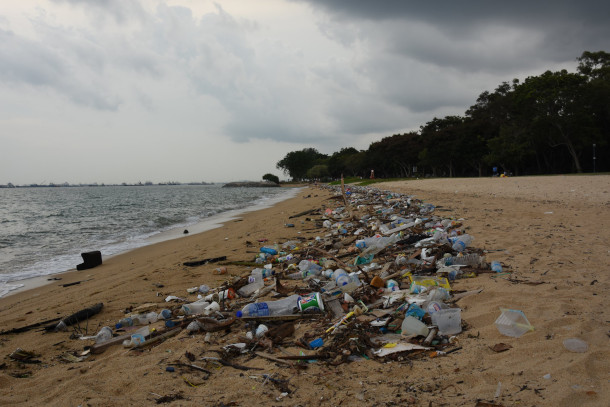
Delegates agreed during the negotiations that the treaty will cover the full life cycle of plastic, from creation to disposal. (Photo: vaidehi shah, Flickr, CC BY 2.0)
CURWOOD: From PRX and the Jennifer and Ted Stanley Studios at the University of Massachusetts Boston, this is Living on Earth. I’m Steve Curwood.
BASCOMB: And I’m Bobby Bascomb.
The world produces around 300 million pounds of plastic each year. Less than 10 percent is recycled, some is incinerated but the vast majority ends up in our landfills and oceans where it pollutes and kills marine life. So, in March, delegates at the UN Environment Program committed to creating a legally binding agreement to tackle the plastic crisis all the way from production to disposal–its full “life cycle”. The first of five negotiating meetings, which will eventually produce a treaty document recently wrapped up in Punta del Este, Uruguay. For more I’m joined now by Margaret Spring, the Chief Conservation and Science Officer at the Monterey Bay Aquarium. She attended the negotiations as an observer and delivered the statement from the science and technology major group at the talks. Margaret, welcome to Living on Earth!
SPRING: Thank you. It's great to be here today.
BASCOMB: Now, there are many different ways to write an international agreement like this. And it's very complicated, of course, and every country has their own interests and opinions on how to go about it. From what I've read, there were two basic approaches to creating the agreement that were discussed here. Can you tell us a bit more about each of those approaches and which countries were sort of leading the charge on each?
SPRING: Okay, well, each country sort of spoke on their own behalf. But if you talk about the countries who are part of the High Ambition Coalition, they're asking for a legally binding convention or treaty with specific control measures in the treaty and uniform rules of the road, essentially, that everyone would have to comply with, and then implement those through national plans of action and reporting. What the United States and others were promoting was to have a general goal in an agreement and to set all of the specific control measures in their national plans. So the country could decide how they wanted to meet that goal, without any uniform rules of the road across the global space. So I think that's the difference, is that the High Ambition Coalition and other countries are more interested in seeing everyone have the same rules, and implement them the way it makes sense in your country. But the US and other approaches were more to say, give us the general goal, and we'll figure out how to implement it at home. It's subtle, but important, because plastic is traded and moves around the globe without much country specific control, always. So really, there was a strong argument for a global agreement on those restrictions.
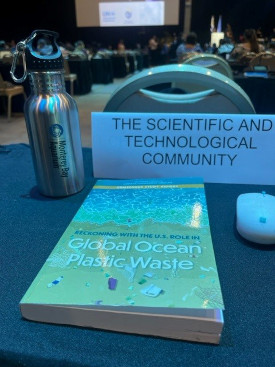
Margaret Spring, who observed the talks for the International Science Council, says delegates were eager to receive scientific input and guidance. (Photo: Courtesy of Margaret Spring)
BASCOMB: Well, the instrument approach favored by the United States is more similar, I think, to the Paris Agreement, which was a landmark agreement, of course, to address greenhouse gas emissions. But that was agreed to seven years ago. And now a lot of observers would agree, I think, that progress on the wonderful goals laid out there have actually been pretty slow in coming, you know, to the frustration of many. So what was the argument to emulate that model when it comes to curbing plastics?
SPRING: The sense I got from that discussion was that the United States was very strongly in support of a zero-plastic pollution in the environment by 2040, which is the same goal articulated by the High Ambition Coalition. It's just that they disagreed on how to get there. There was a concern that a convention approach might take too long. That was one of the arguments put forward by the United States, that it was more nimble. The United States is taking this approach of a national action plan largely because they state they want to avoid delays associated with ratification of a treaty. And most of the civil society there and others really did not agree with the United States approach. And of course, many of the other countries did not.
BASCOMB: Now we know that chemicals like PFAS and phthalates can be found in many plastics, and they pose serious health threats. To what extent were those chemicals and the health problems associated with them included in the discussions here?
SPRING: They were strongly included in discussions here, certainly, partially because they were raised inside meetings by medical professionals as well as interest groups, but also because they were discussed in the context of briefings of delegates. And the delegates, I think, really learned a lot at this meeting from scientists and others about the potential harms that plastics pose. There have been a number of publications recently, in the last year or so that have really raised this issue. But I felt that the people at the meeting themselves were really talking about this a lot and raising really strong concerns about it. And I was representing the International Science Council in my role there. And I did speak, having discussed with a number of other science professionals, the need for action, because the science we had was very strong on those issues.
BASCOMB: Now, how strong was the lobby presence here? I mean, oil and gas companies stand to lose a whole lot of money if we suddenly start curbing our production of plastic. What kind of influence did you see there?
SPRING: There were a number of people there from various industries, whether they're brands versus plastic producers. The plastic producers I think were more interested in discussing ways to improve recycling. And they were very clear about that. There was some interest on maybe, as the issue of chemicals and toxics came up very strongly in these meetings, in opening this up to more transparency, and so they seem to be moving in that direction. The brands, on the other hand, are very concerned, and a number of them were in a business coalition that spoke at the meeting, and a number of them were actually for source reduction. So there's a real split and a real spectrum of industry there. But there's certainly some concerns about some of the plastic producers really slowing the progress, a fear of that. And I didn't see that in the end because I think that the strong voices for moving fast were still there.
BASCOMB: Right. Well, that's the thing. I mean, the other side of that coin is that the companies that are producing these materials that we're so concerned about have a role to play in reducing the problem.
Plastics are fossil fuels in another form & pose a serious threat to human rights, the climate & biodiversity.
— António Guterres (@antonioguterres) December 2, 2022
As negotiations towards an agreement to #BeatPlasticPollution continue, I call on countries to look beyond waste and turn off the tap on plastic.
SPRING: Absolutely. I mean, that's one of the things that came up was that there needs to be a lot more understanding of how these materials are being produced, what's being put in them, and what threats they pose to human health in particular. And that was a very strong topic of discussion, probably stronger here than at previous meetings, which was the concerns about human health, and the leaching of chemicals and toxics from plastics during their use and during disposal. You heard that from the countries where disposal is a real big problem, such as the Southern hemisphere, as well as from public health providers and doctors who were there at the meeting, who were speaking about the dangers of endocrine disruptors and others. And so that information is largely held by the industry without a lot of transparency. And that is where the industry has to be part of the solution.
BASCOMB: Now from what I understand, there were initially several approaches suggested here, one being to eliminate just single use plastics, another to eliminate marine plastic, you know, address that problem. And the last approach was this sort of lifecycle approach, cradle to grave. And that's ultimately what was agreed upon. Can you tell us a bit more about that lifecycle approach? And what is the plan now in terms of addressing plastic from creation to disposal?
SPRING: That's a great question. I mean, the lifecycle approach was embraced. A number of delegates did say that we need to define what's in each phase of the lifecycle clearly, but I heard some people would say, and I would agree, that the extraction phase is an important part of the production cycle. And that's the beginning, the extraction of the materials. Over 90% of plastics are made from fossil feedstocks. So you really have to look at that stage, and then keep moving your way through. So there are some people, I thought, were saying that the plastic lifecycle starts at the creation of the plastic. So that's an area that has got to get sorted out. One piece of plastic can make its way all the way through to the environment, or to a landfill or into recycling. But what happens to it really has to be decided when it's created, or else you're not going to win this game.
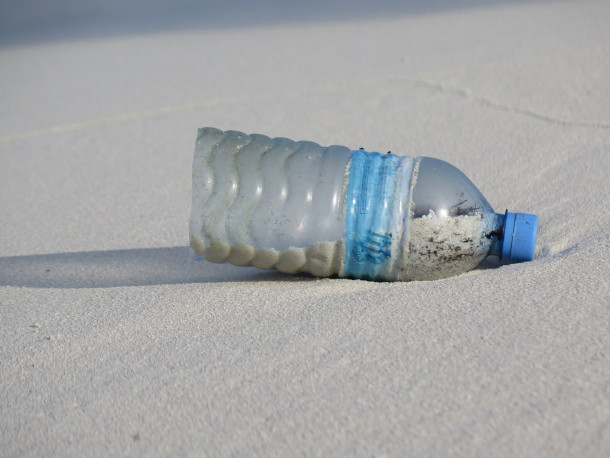
Endocrine disrupting chemicals, like PFAS and phthalates, are present in many plastics, and countries emphasized the risks they pose to human health during the treaty talks. (Photo: The Reef-World Foundation, Flickr, CC BY-NC-ND 2.0)
BASCOMB: Now, this meeting in Uruguay also addressed support for waste pickers. Those are the people who come through waste looking for valuable items to sell. Can you tell us more about that, please? What was decided here?
SPRING: Well, it was very clear that the nations wanted to see the informal waste sector, or some people call them waste pickers, specifically provided for in an agreement. And there was a coalition that was launched at the meeting called the Just Transition Coalition, that was supposed to elevate the role of the waste pickers in the negotiations. And so I think that was achieved. But the specific requirements would be transition for them in whatever the final agreement is for their jobs, but also for improving the health and safety of those workers who really are at risk and working with these materials. And so the the health issues came up with respect to them, as well as the need for an economic solution for these countries and these people who are within that system, and are providing a very excellent role, because they're actually reducing the amount of waste that is going into the environment.
BASCOMB: So what's the take home from this meeting? What actually was accomplished here?
SPRING: So I think we saw a continued commitment by the countries to take urgent action and stick to a fast timeline on this. And there was a strong commitment to a legally binding and cradle to grave a full lifecycle approach, which is great. There was also a really strong commitment to scientific input and guidance on many of these complex issues. And so I think that's going to really be helpful in the long run. What really came through was the need to address both the environment and health dimensions, including human rights, and that civil society or people have to be involved in the negotiation to get this right. Strong support for precautionary principle, polluter pays principles, and the human rights to a healthy environment. And I'm really looking forward to seeing the Secretariat develop what they're calling an elements paper, which would be submitted in advance of the next meeting with core obligations, control measures, voluntary approaches, implementation measures and the like, to help set the stage for the next negotiation. So I think we've set it up for success if we can stay on track.
BASCOMB: Margaret Spring is the Chief Conservation and Science Officer at the Monterey Bay Aquarium. Margaret, thank you so much for your time today.
SPRING: Thanks so much. Appreciate being here.
Related links:
- International Science Council | “Negotiations on Ending Global Plastic Pollution Must Be Informed By Scientific Assessment”
- International Science Council | “Science and Technology Major Group Statement for the Opening of the INC-1”
- UNEP | “INC to Develop an International Legally Binding Instrument”
- Living on Earth | “Nations Vow to Curb Plastic Waste”
[MUSIC: Hank Mobley, “Dig Dis – Remastered 1999/Rudy Van Gelder Edition” on Soul Station, Blue Note Records.]
CURWOOD: Coming up – Green voters and the midterm elections.
ANNOUNCER: Support for Living on Earth comes from Sailors for the Sea and Oceana. Helping boaters race clean, sail green and protect the seas they love. More information @sailorsforthesea.org. Support also comes from Friends of Smeagull the Seagull and Smeagull’s Guide to Wildlife. It’s all about the wildlife right next door to you! That’s Smeagull, S - M - E - A - G - U - L - L, SmeagullGuide.org.
[CUTAWAY MUSIC: Hank Mobley, “Dig Dis – Remastered 1999/Rudy Van Gelder Edition” on Soul Station, Blue Note Records.]
Beyond the Headlines
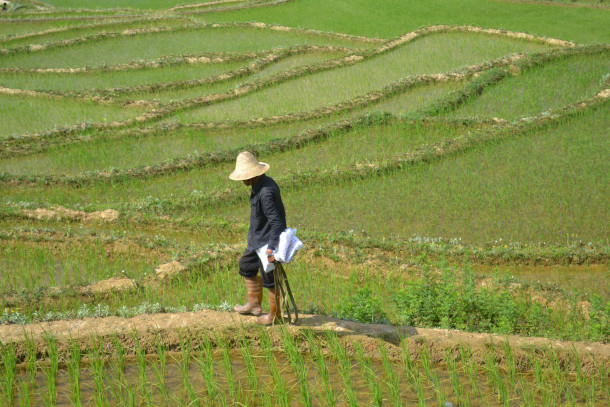
China has 7% of the world’s arable land but accounts for one-third of global chemical fertilizer use. (Photo: Courtesy of Natalia Chernenko, Unsplash)
BASCOMB: It’s Living on Earth, I’m Bobby Bascomb
CURWOOD: And I’m Steve Curwood.
And on the line now from Atlanta, Georgia is Peter Dykstra. He's an editor with Environmental Health News–that's ehn.org–and dailyclimate.org. Hey, Peter, I know that you have a lot of athletics in your town, but more recently you had multiple races for the United States Senate. I guess Mr. Warnock is going to be going back there after all.
DYKSTRA: Well, hi, Steve. Yeah. And it's–we're talking about a victory by incumbent senator Reverend Raphael Warnock over Herschel Walker. Just a quick comparison: Warnock had a 100% score in the last full year, 2021, from the League of Conservation Voters. Herschel Walker has run before but the last times he ran were in the National Football League at the University of Georgia where he won the Heisman trophy, and in the short-lived US Football League, where he ran for a team owned by real estate mogul Donald Trump.
CURWOOD: Yeah, so I guess they had met before. What do you think this means now for environmental and climate issues in the Senate?
DYKSTRA: Well, having a true majority in the Senate for the Democrats, plus their two independents, means that they can pick their own committee assignments and overcome any delays or hassles, at least in the Senate, not just by Republicans, but also by sometimes reticent Democrats, like Senator Joe Manchin of West Virginia, who is proven to be a reliable friend of the coal and petroleum industries.
CURWOOD: Okay. Hey, Peter, what else do you have for us today?
DYKSTRA: A little possible good news from China. Their foreign ministry has announced a goal of a 10% cut in pesticide use on food crops by the year 2025.
CURWOOD: How much pesticides do they use anyway?
DYKSTRA: Well, here's one indication, not of pesticides, but a farm impact overall: Foreign Ministry of China says they have 7% of the world's arable land, and they use roughly 1/3 of the world's chemical fertilizers on that 7% of the land.
CURWOOD: Well, and of course, pesticides are linked to degrading the soil, polluting the water. And human exposure is often, let's put it mildly, not very healthy.
DYKSTRA: Not at all, and it's a step forward, but it's a step forward from a nation whose pesticide use has been notoriously backward.
CURWOOD: Okay, tell me, what else do you have in the way of news?

Gray wolf population management is highly contested in Montana. (Photo: Courtesy of Yellowstone National Park, Flickr, Public Domain)
DYKSTRA: One thing that caught my eye was from the state of Montana, where a judge has refused to grant an injunction to two environmental groups that want to halt the very controversial, very aggressive hunting of wolves within the state that was put into motion by Montana's new Governor Greg Gianforte, who, interestingly enough, was replaced from his time as a congressman by a previous congressman, former Interior Secretary, Ryan Zinke.
CURWOOD: Let's take a look now in the annals of history and tell me what you see.
DYKSTRA: December 8th, 1995, was the day that many states acted on a bill passed by Congress signed in November '95 by President Bill Clinton to roll back the 55 mile an hour speed limit. That speed limit had been in effect for 21 years, ever since the energy crisis during the Nixon administration. Its proponents say that the 55 mile an hour speed limit saved lives and saved millions of barrels of oil. Proponents of getting rid of the ban say that it imposed on drivers' personal freedom and also cost a lot of money by slowing down the nation's trucking fleet and their delivery of goods.
CURWOOD: Even in 1995 if you did 55 miles an hour on many interstates, you'd get rear-ended.
DYKSTRA: Very, very few people out there–I would plead guilty to this myself–pay strict attention to whatever the speed limit is. Many of us tend to cheat a little bit but the 55 mile an hour speed limit drove many drivers crazy.
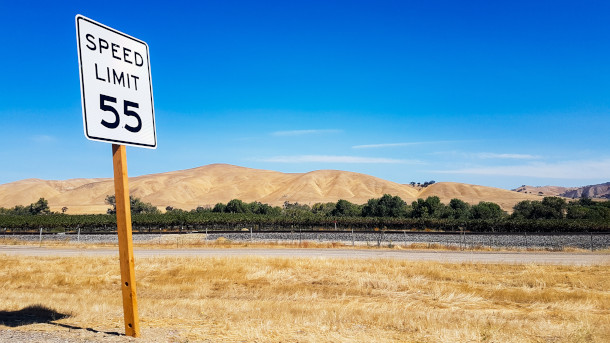
December 8th, 1995, was the day many states stopped enforcing the 55 mph federal speed limit when it was repealed by the National Highway System Designation Act of 1995. (Photo: Courtesy of Ludovic Charlet, Unsplash)
CURWOOD: Hey, thanks, Peter. Peter Dykstra is an editor with Environmental Health News. That's ehn.org and dailyclimate.org. We'll talk to you again real soon.
DYKSTRA: All right, Steve, great. We'll talk to you soon.
CURWOOD: And there's more on these stories on the Living on Earth webpage. That's loe.org.
Related links:
- Reuters | “China Eyes 10% Cut in Pesticide Use on Fruit, Vegetables By 2025”
- Click here to see Raphael Warnock’s stellar track record on environmental issues:
- The Intercept | “Montana Judge Won’t Halt Gov. Greg Gianforte’s Aggressive Wolf Hunt”
- Read more about the history of the federal 55 mph speed limit here:
[MUSIC: The Cars “Drive” on Heartbeat City, Elektra/Asylum Records]
Green Voters Help Democrats

US Senator Raphael Warnock (D-GA) speaks at an August 2022 campaign event. Warnock won reelection this week against Herschel Walker. (Photo: Courtesy of John Ramspott, Flickr, CC BY-ND 2.0)
CURWOOD: The re-election of Democratic Senator Raphael Warnock in the Georgia runoff December 5th finished the midterm election season with a solid win that delivered full majority power in the Senate for Democrats, even though Republicans did wrest control of the House from the Dems. Democrats performed better than many had expected and part of their power nationwide is the growing number of voters who list climate and environment as their top priority. For some insights into these green voters and their impact on the midterm elections, I’m joined by Nathaniel Stinnett, founder, and executive director of the Environmental Voter Project. Nathaniel, welcome back to Living on Earth!
STINNETT: Thank you so much. It's so great to be back.
CURWOOD: So for a moment, let's talk about an environmental voter. What are the criteria that determines that title? And what are some of the common demographics for these super environmentalist?
STINNETT: So when we at the Environmental Voter Project are identifying what we call environmental voters, we're trying to isolate people who care so deeply about climate and environmental issues, that it's their number one priority. And those people are disproportionately young. They are disproportionately people of color, especially Asian American and Hispanic. And there are disproportionately people of lower income, people who tend to make less than $50,000 a year.
CURWOOD: Now, when we've spoken in the past, who said one of the characteristics of environmental voters is that they don't vote very often, and so they don't get targeted by people in campaigns. What happened this time? How did the environmental voter turnout compare in this midterm to the 2020 or 2018 elections?
STINNETT: So we don't have a lot of the data from election day yet, because it takes a few months for that data to sort of flush through the voter files. But we do have a very clear picture of what happened during early voting. And in early voting, people who cared deeply about the environment consistently outperformed the overall electorate, by which I mean, if you look at turnout of registered voters, about 33, 34% of registered voters showed up and voted early in most states, whereas environmentalists sometimes were as high as 40, 45, or 50%. Now part of that has to do with just the fact that early voting itself has become partisan, which sounds kind of crazy. But the more progressive you are, the more likely you are to vote early. And so what I would not claim is that we should look at that early voting data and say, “Oh, environmentalists voted more often than the overall electorate.” In fact, I am not comfortable saying that, because we would expect environmentalists to do better in early voting. But whereas we typically see environmentalists vote at lower rates than the overall electorate, they performed so well, during early voting, that I'm thinking when we get all of the data in, it's going to end up being pretty even.
CURWOOD: Interesting. Let's just take a moment to speculate. Nathaniel, what do you think is getting these climate voters to the polls on Election Day?
STINNETT: I guess first just for some baseline data. When we looked at exit polls in the 2020 presidential election, 4% of voters said that climate was their number one priority. Exit polls in the recent midterms, showed that 9% said that climate was their number one priority. Now to be clear, that's an apples and oranges comparison. Presidential voters are different from midterm voters. But clearly there's this growth. But to get to your question, Steve, I think a lot of people would say that climate change and climate politics was more of the zeitgeist around the presidential election than it wasn't this recent midterm. People were talking about the dobs decision for the midterm, and they were talking about inflation, and they were talking about guns and cost of living. They weren't really talking that much about the climate crisis. And so all I can do is speculate here. But what I think was going on, is that the Inflation Reduction Act made a lot of people who cared deeply about climate move from being kind of disappointed in the Biden administration, to having the wind at their backs. No, I'm not going to claim that this was a climate election. It most definitely was not. But something made a whole lot of disappointed and disengaged environmentalists show up. And I got to think that the Inflation Reduction Act had a lot to do with that.
CURWOOD: So where does the environmental voter lie in the coalition that seems to be the basis of the Democrats these days? Not just demographics, but people supporting reproductive rights, LGBTQ, labor.
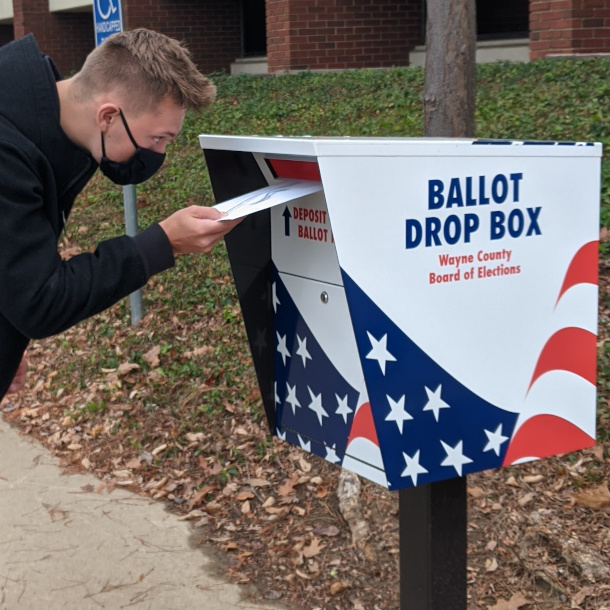
Around 6,000 super-environmentalists who did not vote in the original 2022 midterm election sent in a ballot for the subsequent Georgia runoffs. (Photo: Karri VanKirk, Flickr, CC BY-NC 2.0)
STINNETT: It varies by region. But we see very, very strong correlations between people who care deeply about climate and people who care deeply about other issues that are core to the modern Democratic Party's ideology. So in the northeast, we see very, very strong correlations between climate voters and people who care deeply about a woman's right to choose. In the Mountain West and the Southwest, we see strong correlations between people who care about climate change and people who care about gun control. Now, I think it is likely that you would see a lot of overlap, if you looked at any sort of progressive issue constituency group, but those two particular instances are really, really so prevalent that it pops out at us whenever we look in those two places. And then the final thing I'll say is it is hard to avoid demographics here. As I'm sure is no surprise to you, Steve, people who care deeply about the climate crisis are really, really young, they are disproportionately young. And people who care about those other issues that I just mentioned to you often happen to be very young as well. And so, obviously, it's important to discuss ideology. But as politics becomes increasingly tribal, identity is unavoidable, and who you are often helps define what issues you care most about.
CURWOOD: Nathaniel, let's take a look at Georgia for a moment. What was notable about environment, first voters and this year's midterms and, of course, the runoff itself?
A HUGE thank you to our amazing donors & volunteers. With your help, we mobilized over 130,000 low propensity environmental voters over 3 weeks in the #GeorgiaRunoff:
— Environmental Voter Project (@Enviro_Voter) December 7, 2022
506,815 phone calls
248,972 pcs of direct mail
8.8 million dig ad impressions
15,917 of our targets voted early
STINNETT: In the midterms, we saw from exit polling data that 6% of voters listed climate as their top priority. Now that was lower than the national average for the midterms; the national average was 9%. But it was still pretty high. Because if we go back to 2020 in Georgia, only 2% of voters listed climate as their top priority. So again, I won't claim that climate voters were the story of the midterms in Georgia. But boy, are they more powerful now than they were two or four years ago. We really saw something extraordinary in the early voting data in the runoff election. So 12% of all early votes that were cast, were cast by climate first voters. When you compare that to the midterm, that was down at 11%. And that 1% is actually a pretty big number when again, you consider the universe of climate voters is not that big in Georgia. So they really, really showed up in pretty significant numbers. And what I think is really important to point out is almost 6,000 of these climate first voters in Georgia who voted in the runoff election, didn't even vote in the midterm. Now, again, is that 6,000 votes a difference maker in an election that were not won by 100,000? No, of course it isn't. But something was going on there. People who care deeply about climate and environmental issues, not only viewed this as an important election, but viewed it as significantly more important than the national midterms that had just happened a few weeks earlier. I think it was important for a few reasons. It's been hard for Kamala Harris to get more than 10 miles away from DC these past few years, because she's had to be the tiebreaker on a lot of important pieces of legislation, including a lot of important pieces of climate legislation. She won't have to do that anymore in a 51 to 49 Senate. Similarly, Democrats will hold a majority on a lot of these Senate Committees. But perhaps most importantly, I don't think we should just view this as the final Senate election of 2022. I think we should also think of it as the first Senate election of 2024. And in 2024, it's a really hard Senate map for Democrats. Democrats will be defending Senate seats in some pretty red states. And to the extent Democrats are going to be the ones proposing federal climate legislation, which they tend to be, I think it's really, really important for them that they're going into that hard 2024 Senate cycle with this extra seat that Raphael Warnock just won. And so this is this is really, really important, not just for this year and next year, but for 2024.
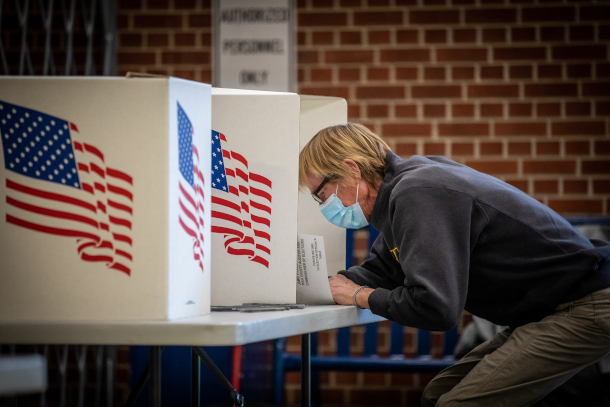
An estimated 850,000 registered voters in Georgia consider climate or the environment to be their top priority when it comes to voting. The Environmental Voter Project focuses on getting out the vote to registered voters who are unlikely to vote in elections. (Photo: Phil Roeder, Flickr, CC BY 2.0)
CURWOOD: Now, let's face it, presidential primaries are now just a little more than a year away in certain places. Where do you see the role of the environmental voter bloc, say, in 2024?
STINNETT: The best way to make a new environmental voter in 2024 is to talk to them in 2023. So first, I would say swing state mayoral elections in places like Philadelphia, Pennsylvania, or Jacksonville, Florida, or Tucson, Arizona, are going to be very, very important because those are the elections where brand new environmental voters are going to be born. But when we then move ahead into the primary season and 2024. Well, as you know, Steve, the primary calendar might be mixed up a little bit this time around. Yeah. And particularly in states like Nevada, where, at the Environmental Voter Project, we've identified a huge population of environmental voters, well, they are going to have a disproportionately large amount of sway, not just over the Democratic primary, but also over the Republican primary. I won't claim that there are enormous numbers of climate voters who vote in the Republican primaries, but there aren't enormous numbers of voters period who voted primaries. So even small numbers can actually move things on the margins in the primaries.
CURWOOD: So what advice what cues? Do you suggest that politicians might take moving forward about courting the environmental voters out there?

Nathaniel Stinnett serves as Founder and Executive Director of the Environmental Voter Project. (Photo: Courtesy of the Environmental Voter Project)
STINNETT: First, I would say, you don't need to be scared. What all of our polling shows, and what a whole lot of public polling from the Yale Program on Climate Change Communications and Pew Research shows is that there are very few independents and even Republicans who don't want action on climate change. Maybe it's not a high priority for those independents and Republicans, but very, very few of them oppose it. So although I would never claim that climate is the number one most important issue to huge numbers of Americans, that is not the case. In fact, the very point of the Environmental Voter Project is we recognize that we need to make more climate voters. But what I would say to politicians is there's very little downside to leading on climate. What all of the polling shows, public or private, is that there are very, very few climate haters and environment haters out there. And so, I would claim to politicians that this is an easy win for you. You're not going to make many enemies you're not gonna make many people refuse to vote for you by pushing for more clean energy and more jobs in the clean energy sector. That's an easy win.
CURWOOD: Nathaniel Stinnett is the founder and executive director of the Environmental Voter Project. Nathaniel, thanks so much for taking the time with us today.
STINNETT: Thank you for having me, Steve.
Related link:
Learn more about the Environmental Voter Project
[MUSIC: Ray Charles “Georgia on My Mind – Original Master Recording” Single, The Ray Charles Foundation / Tangerine Records]
BASCOMB: Coming up – Indigenous stories of sea level rise that have been passed down for thousands of years. Keep listening to Living on Earth.
ANNOUNCER: Funding for Living on Earth comes from you, our listeners, and United Technologies, combining passion for science with engineering to create solutions designed for sustainability in aerospace, building industries, and food refrigeration.
[CUTAWAY MUSIC: Ray Charles, Milt Jackson, “Hallelujah, I Love Her So” on Soul Brothers/Soul Meeting, Atlantic Recording Corporation]
Bipartisan Support for Offshore Wind
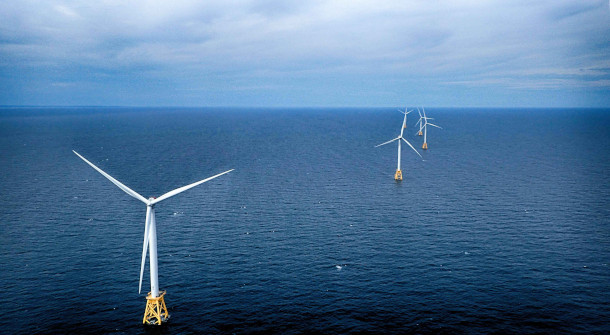
The five Alstom Haliade 6 MW turbines of the Block Island Wind Farm near Rhode Island. The wind farm was the first to operate in U.S. waters. Several Louisiana companies with roots in the offshore oil and gas industry helped design and build the farm. (Photo: Ionna 22, Wikimedia Commons, CC BY-SA 4.0)
BASCOMB: It’s Living on Earth, I’m Bobby Bascomb
CURWOOD: And I’m Steve Curwood
On December 6th, the US held its first ever lease auctions for commercial scale floating wind farms. Those were for California and the Biden Administration recently announced more areas for offshore wind; this time in the Gulf of Mexico near Louisiana and Texas. Offshore wind takes advantage of the engineering used for offshore oil and gas platforms and revenues are shared with the adjacent states. Now there is a bipartisan effort to update offshore revenue sharing rules that date back to early days of oil and gas production. Two congressmen from Louisiana, Democrat Troy Carter and Republican Steve Scalise, currently the number two House Republican leader, are advancing what they call the Breeze Act. This would give states a larger share of offshore royalties than before, incentivize work force diversity and dedicate more funding to coastal restoration and protections. I reached Congressman Carter on the line at his office in New Orleans. Welcome to Living on Earth!
CARTER: Hey, thank you very much. I'm happy to be with you.
CURWOOD: Congressman, how does this announcement of the designation of zones for offshore wind affect the outlook for the wind energy sector and clean energy in general?
CARTER: Well, I think it's a huge step in the right direction. It's an opportunity to really demonstrate that the administration and Congress is serious about reducing our dependency on fossil fuels. Louisiana is a perfect place for it. And I think this is a very, very good thing. Very excited about what it means.
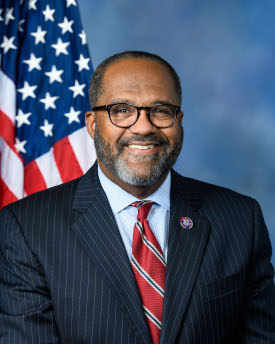
Troy Anthony Carter is an American Democratic politician serving as the U.S. Representative for Louisiana’s 2nd congressional district since 2021. (Photo by U.S. House of Representatives, Wikimedia Commons, Public Domain)
CURWOOD: Now you're a Democrat. And from what I understand in July, you and Republican Steve Scalise introduced the Budgeting for Renewable Electrical Energy Zone Earnings Act called BREEZE, which sets the stage to invest and collect revenue from offshore wind. What's the idea behind this?
CARTER: Well, you know, I have worked tirelessly to try to convince brothers and sisters on the other side of the aisle that clean energy and renewables should not be a partisan issue. This is something that we should work on together, recognizing that we have one Earth, and we've got to protect it. We got one shoreline, the importance of protecting our coasts and those revenues that come from exploration of oil and gas, undoubtably, will be changing. So when we shift to wind, we want to make sure that those revenues that come back to Louisiana, and our revenue sharing does not decrease because we still have a shrinking coastline. So the BREEZE Act is a perfect way to demonstrate one, a commitment but two, the necessity to protect Louisiana's coast.
CURWOOD: So talk to me a little bit about politics here. Steven Scalise is a big member of the Republican Party, he's in the leadership there in the House. And now that the House is now ever so slightly majority Republican, how does that affect the prospects of this measure?
CARTER: Well, it increases it. When we were in charge, I was pushing it hard for my end. Now he pushed it hard from his end. And I know sometimes in Republican circles and Democratic circles, sometimes we bump heads in those issues. Regardless of party affiliation, we got to put people before politics, and we've got to advance those issues that are good for the American people, the Louisiana people, the people of Earth. So I feel very confident as I did when the Democrats are in charge. This is one of those measures that just makes sense.
CURWOOD: Now, this legislation were to be enacted would also cover Texas, which is another major Gulf state. And I think the expectation is that there'll be a lot of offshore wind there as well. What support, if any, are you getting from the Texas delegation?
CARTER: Support has been great. I think that it makes perfect sense. You'd have to really dig deep to be opposed to this. Every now and then you come across legislation that just makes sense. And I expect that the discussions and conversation we've had thus far been very good. I don't anticipate any pushback, because they will enjoy the same benefit that we're fighting for Louisiana, and they have similar issues to protect.
CURWOOD: Now with the advent of offshore wind energy, what's being done for equitable distribution of opportunities for more diverse companies to get into this project, and not just the fossil fuel crowd, which of course, has a leg up because they've been doing offshore platforms for a long time?
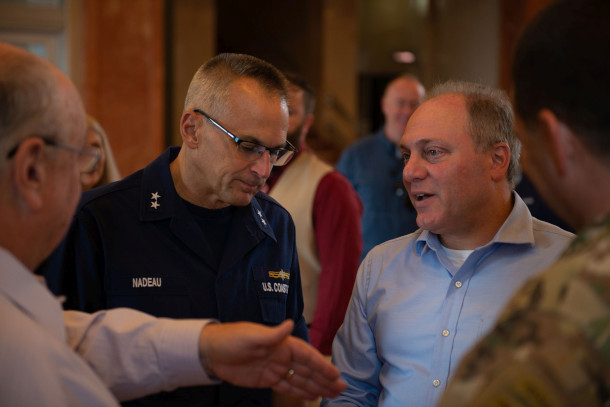
Rep. Steve Scalise (R-LA, right) speaks with Rear Admiral John Nadeau (left) from the United States Coast Guard. (Photo: Petty Officer 3rd Class John Michelli, Coast Guard News, Flickr, CC BY-NC-ND 2.0)
CARTER: Well, you know, the hope is that all of the ancillary businesses that are out there. Opportunities to work with minority business development associations, working with the various ancillary groups, working with the local economic development arms, that as we grow into a new era of how we do things, that we are much more sensitive to diversity and inclusion, and working with local players on the ground. And so making sure that opportunity for women-owned, African American owned, disadvantaged business, minority-owned enterprises have an opportunity to participate in this new emerging opportunity as we look to wind and greener energy.
CURWOOD: Now some projections say that offshore wind there in Louisiana, could supply enough electricity to take care of metropolitan New Orleans. And of course, if you don't burn fossil fuel to make electricity, you don't create pollution. What are the local power plants that these wind farms hopefully will replace, and what's the expectation what will happen to air quality there?
CARTER: When we're able to fuel our towns and cities with wind, we save our environment, we save people that have had to endure less than perfect quality of air. It's the kind of win-win, pun intended, that we've hoped for, that we know is out there. And we continue to see issues with poor quality of health and people who are impacted like anything else, the ebbs and flows, having cleaner new technologies, power companies have to figure out how to be a part of the change. Our intent is not to put anyone out of business, our intent is not to decrease the value of our economy. It is to change and protect our environment. Just because we've always done it that way doesn't mean it's the right way. And I will tell you, conversations I've had with oil and gas, with power companies, they recognize and I've encouraged them to recognize changes coming. Come and be a part of it. Let's do what's right by the people.
The Gulf of Mexico’s first offshore wind farms will be developed off the coasts of Texas and Louisiana, the Biden administration announced Wednesday. Together they’re projected to produce enough energy to power around 3 million homes. https://t.co/g2HRDWSYSl
— Texas Tribune (@TexasTribune) July 22, 2022
CURWOOD: The oil and gas industry is nervous to be blunt about getting put out of business by renewables. How are you getting them to buy into this project?
CARTER: Whenever you have limited regulation, and someone says, now we want to step up regulation, when you've been accustomed to doing things one way, now someone says let's do something another way. Well, no one likes to necessarily upset their formula. But as I have said, coexistence is the order of the day. And oil and gas companies have to come along with us. They have to find new ways to do what they do cleaner, safer ways; embrace wind, embrace new technologies. I don't view the old, the past as the enemy, I just view it as in need of an overhaul. And so encourage oil and gas companies to recognize, “Listen, you can come kicking and screaming, or you can be a part of the change.” And the change is going to come because we're going to continue to fight for economy, for the environment. And wind is a great opportunity to demonstrate how we can have a cleaner environment, how we can have a stronger dependency on ourselves and not on fossil fuels for a cleaner way of doing business. And when you talk to many of the oil and gas execs, they see it and they know it's coming. I've encouraged them to embrace it. And let's do it in partnership. So it's not us against them.
CURWOOD: Louisiana has a sizable fishing fleet, what kind of provisions have been considered so that people fishing aren't affected by where these towers are placed?
CARTER: The reality is many of the places where we have platforms now, we're able to kind of see where it makes sense that we can utilize resources. As you know, we use those platforms, they create great coral reef and end up being great artificial reef where fishermen and fisher people can go and fish. So all of our actions are obviously very, very sensitive to our bustling seafood industry, are all issues that are very much in the forefront of how we advance. So now we are taking a very deliberate, careful approach to make sure that in an effort to create clean energy, we're not harming our fisheries and our waterways.
CURWOOD: Offshore wind projects can take a long time to work on and develop and although the current Biden administration is supporting this, administration's do come and go. How do you plan to get this project up and running far enough and fast enough within the next two years that it can't be stopped by a change of administration?
CARTER: Well we have multiple tracks. One is we make sure that the Biden-Harris administration gets a second term. That's the safest bet. But in the interim, it is to continue to educate Republicans, Independents and others that there are a lot of things that could be, should be considered partisan, and some shouldn't. Making sure that we're protecting our Earth shouldn't be partisan. Hence the BREEZE Act having the number two Republican in the House of Representatives to go off that with me, Steve Scalise. I will continue as I've done my entire career, making sure that we depoliticize the value of our own energy independence. Things change. And when we make those changes, we should take into consideration what's best for the people, what's best for our economy, what's best for jobs, and what's best for our independence.
CURWOOD: Troy Carter is the Democratic congressman from Louisiana Second Congressional District. Thank you so much for taking this time with me today.
CARTER: Thank you very much. I thoroughly enjoyed it and hope that we can do it again sometime soon.
Related links:
- Nola | “Gulf's First Two Zones for Offshore Wind Farms Selected Off Louisiana, Texas”
- Biz New Orleans | “Bill Would Increase Louisiana’s Share of Oil and Gas Revenue”
[MUSIC: Billy Branch, “Back Alley Cat” on Blind Pig Presents: Night Time Blues, Whole Hog, Inc.]
Ancient Stories of Sea Level Rise
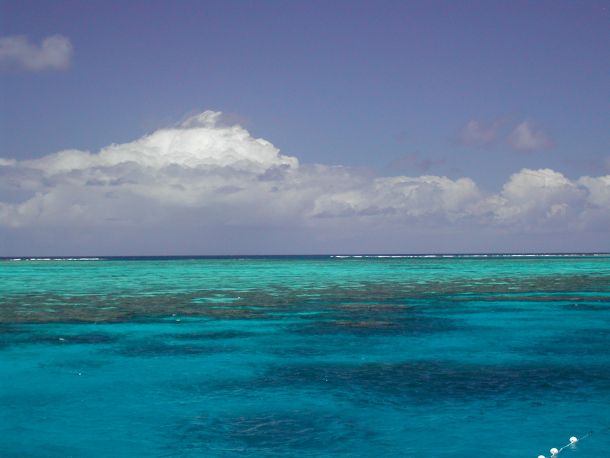
The Great Barrier Reef, located off the coast of Queensland, Australia, is the world’s largest coral reef system. (Photo: Pete Edgeler, Flickr, CC BY-NC-ND 2.0)
BASCOMB: Climate change is expected to deliver substantial sea level rise in the coming decades. That will dramatically change coastal areas as we know them, but this isn’t the first global sea level rise humans have lived through. In fact, previous interglacial periods of warming caused dramatic sea level rise worldwide. And many indigenous peoples have stories of sea level rise that they passed down through countless generations, in some cases these stories have persisted for thousands of years. That’s according to research conducted by Patrick Nunn, a geographer and geologist at University of Sunshine Coast in Australia. Welcome to Living on Earth, Patrick.
NUNN: Many thanks. I'm delighted to be here.
BASCOMB: So your research mainly focused in Australia, you collected stories from about 32 Aboriginal groups around the continent. Can you tell us one or two of those stories, please?
NUNN: Well, sure, someone was actually telling me a story the other day that I hadn't heard before. It's the story of some ancestral being named Gunya. And he was living in North East Australia, where the Great Barrier Reef is today. And the Great Barrier Reef at the time was all dry land. Gunya and his people walked across this area, they named different places, they developed associations with different places, most of which are still underwater. But this gentleman was saying to me, well, you know, today, we still recognize that island over there as being the top of the hill. And the story then goes on to talk about how the ocean surface rose and started to gradually flood this huge area of land that is today, the Great Barrier Reef, and it drove the people landward. They suddenly found themselves living together in diverse groups, which they never had before and speaking different languages. And when I first encountered these stories, it became clear to me that they were recalling the rise in the ocean surface that occurred after the last ice age, after the end of the last ice age. So roughly between about 15,000, and in Australia, around 7,000 years ago. Seven thousand years ago was when the ocean surface reached its present level around Australia. And since then, it's been reasonably stable. So it's a story I love because it has a social element to it. It talks about the societal disruption, which accompanied this rise of sea level and that's something you don't find in all of these stories.
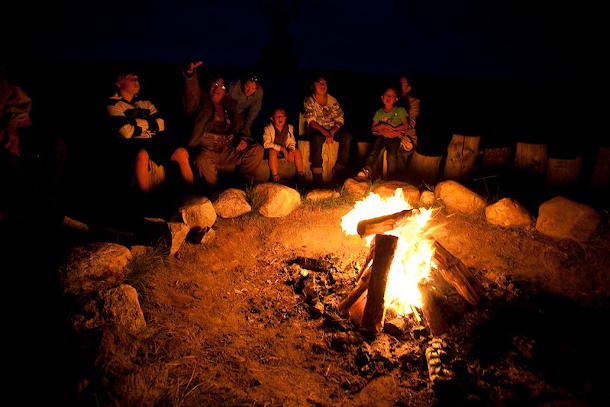
For thousands of years, humans have made sense of the world around them through stories. (Photo: Viaje a Canada, Flickr, CC BY-NC-ND 2.0)
BASCOMB: And so for a story to persist for 7,000 years, it's got to be a pretty good story, right? You know, just saying, “Hey, there used to be more water. And now there's not,” that's not gonna stand the test of time very well, I think.
NUNN: What a lot of people think when they hear that the story could have persisted, passed on by word of mouth for more than 300 generations. The problem that a lot of people today have with that kind of suggestion is the word "story." We tend to think of a story as something invented or something entertaining, whereas I think, if you go back 7,000 years, stories were education, they were practical information. And the importance of conveying that information from one generation to the next was all about survival. If you wanted your children and your children's children to survive, they had to know everything that you knew, and your ancestors knew about this changing uncertain world in which they lived. And that, I think, is why those stories were preserved for so long. Because it wasn't an option to learn those stories. It was a requirement.
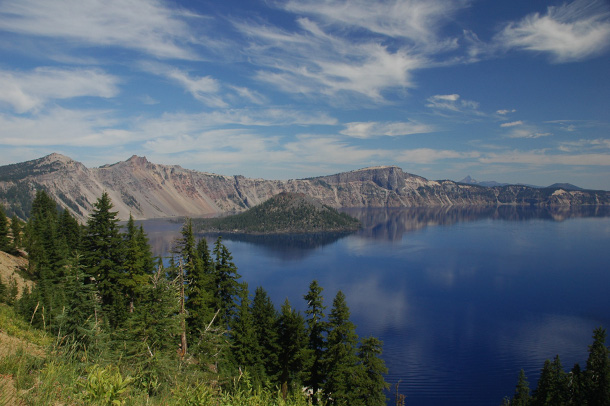
Crater Lake in Oregon was once home to a large volcano that erupted and collapsed on itself. (Photo: informedmindstravel, Flickr, CC BY-NC-ND 2.0)
BASCOMB: Do you think that these types of stories are more important in a place like Australia? I mean, it's extremely dry. There's some of the world's most toxic and venomous snakes and scorpions and spiders. I mean, everything there is trying to kill you. It's such a harsh environment. Do you think that these types of stories become more important to survivability in a place like Australia?
NUNN: Absolutely, it is because Australia is such a harsh environment, and that water is generally so difficult to find. I think that the indigenous people of Australia, who arrived there probably around 70,000 years ago, and really didn't have a lot of contact with the outside world until European settlers arrived. That isolation, combined with the harshness of the Australian environment, also really gave us a perfect set of circumstances for developing and preserving these kinds of oral traditions.
BASCOMB: Gosh, that's just amazing. It's such an interesting approach to looking at the world. You know, I think a lot of scientists hearing these stories might think “Yeah, yeah, sure, that's a nice story.” But not, you know, take it too seriously. What prompted you, though, to take this seriously and look into it further?
NUNN: So most of my research career I have spent in the Pacific Islands, and in the Pacific Islands, there were and there still are a lot of usually older people who are not literate, who can't read or write, who don't necessarily speak very much English, but nonetheless have a vast amount of information that they store in their heads. And when I first encountered such people, it was a real revelation to me that I think literate people tend to be very dismissive of oral information. If it's not written down, it doesn't have doesn't have value, it doesn't have merit, it doesn't have validity. And this is the problem, I think, because I think many oral societies were sustained by a richness and an integrity of oral information that we've largely forgotten about today.
BASCOMB: And there's actually a term for these kinds of stories. They're called geomyths. Can you give some other examples of geomyths?
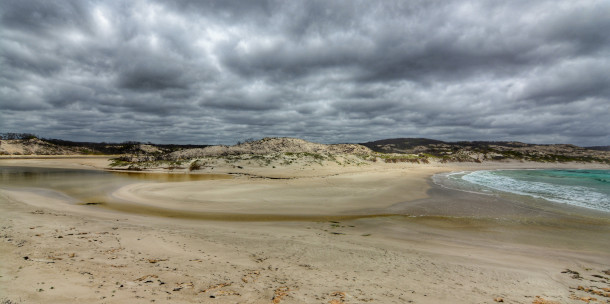
Kangaroo Island, located in South Australia, was once connected to Mainland Australia before rising sea levels separated it. (Photo: John Morton, Flickr, CC BY 2.0)
NUNN: There are lots of other geomyths regarding flood myths. And of course, there are a lot of global flood myths as well. My interpretation of this is that these flood myths evolved in different places. When you got flooded once you generated a story or a myth about that flood. When the next flood came along, then you amplified the previous account and amplified the next account, and so on and so on. There are myths in in other parts of the world about earthquakes and about tsunamis. Where Crater Lake in Oregon is today, there used to be a huge volcano, which we've called today, Mount Mazama. And Mount Mazama blew itself to pieces and collapsed about 7,600 years ago. The first Europeans to get into that area spoke to the Native Americans who live there. And they told the stories over and over again, about that volcano collapsing. That story has persisted for 7,600 years, in an oral context. So it's a mistake to think that geology and the earth sciences developed only in the last 150, 200 years or so. There were people trying to explain the origins of the earth and the way that it was, it seemed to be evolving long before people could write things down. And I think geomyth is really digging back into the distant past in the way that we've never done before. So I think it's really exciting.
BASCOMB: Well, it's really fascinating, I must say. What is your takeaway from doing this research in terms of the importance of including this type of indigenous knowledge with scientific inquiry?
NUNN: Today, we are being confronted by climate changes that are more rapid than they have been for several thousand years. They're not unprecedented in the history of humanity. So the rise of sea level that we're experiencing today, and the rise of sea level that is projected to occur over the next 100 years or so, is less than what it was during the period of post-glacial sea level rise. So I think that we can look back into the past and we can unpack our distant ancestors encounters with rising sea level, and learn from what we can discern of their experiences. We can look into the past, and we can realize that our ancestors survive this period of prolonged and rapid climate change. They survived. And that gives us a certainty, I would say, that it's possible to survive this period of climate change. So the sky is not falling. This is not the end of the world, but our ancestors 7,000, 8,000, 10,000 years ago also had to undertake profound adaptations in order to survive.
BASCOMB: Patrick Nunn is a geographer and geologist at the University of the Sunshine Coast in Australia. Patrick, thank you so much for this time today and all of these wonderful stories.
NUNN: Many thanks, Bobby. I've thoroughly enjoyed it.
Related link:
Scientific American | “Ancient Sea Rise Tale Told Accurately for 10,000 Years”
[MUSIC: Kristian Benton, “Spirit Alive – Music Mosaic Remastered” on Didgeridoo Fantasy, Music a la Carte – Music Mosaic]
CURWOOD: Living on Earth is produced by the World Media Foundation. Our crew includes Fern Alling, Naomi Arenberg, Paloma Beltran, Chloe Chen, Iris Chen, Josh Croom, Jenni Doering, Mark Kausch, Kharishar Kahfi, Mark Seth Lender, Don Lyman, Louis Mallison, Aynsley O’Neill, Sophia Pandelidis, Jake Rego, Ashley Soebroto, and Jolanda Omari.
BASCOMB: Tom Tiger engineered our show. Alison Lirish Dean composed our themes. You can hear us anytime at L-O-E dot org, Apple Podcasts and Google Podcasts, and like us, please, on our Facebook page - Living on Earth. We tweet from @livingonearth. And find us on Instagram at livingonearthradio. I’m Bobby Bascomb.
CURWOOD: And I’m Steve Curwood. Thanks for listening!
ANNOUNCER: Funding for Living on Earth comes from you, our listeners, and from the University of Massachusetts, Boston, in association with its School for the Environment, developing the next generation of environmental leaders. And from the Grantham Foundation for the protection of the environment, supporting strategic communications and collaboration in solving the world’s most pressing environmental problems.
ANNOUNCER 2: PRX.
Living on Earth wants to hear from you!
Living on Earth
62 Calef Highway, Suite 212
Lee, NH 03861
Telephone: 617-287-4121
E-mail: comments@loe.org
Newsletter [Click here]
Donate to Living on Earth!
Living on Earth is an independent media program and relies entirely on contributions from listeners and institutions supporting public service. Please donate now to preserve an independent environmental voice.
NewsletterLiving on Earth offers a weekly delivery of the show's rundown to your mailbox. Sign up for our newsletter today!
 Sailors For The Sea: Be the change you want to sea.
Sailors For The Sea: Be the change you want to sea.
 The Grantham Foundation for the Protection of the Environment: Committed to protecting and improving the health of the global environment.
The Grantham Foundation for the Protection of the Environment: Committed to protecting and improving the health of the global environment.
 Contribute to Living on Earth and receive, as our gift to you, an archival print of one of Mark Seth Lender's extraordinary wildlife photographs. Follow the link to see Mark's current collection of photographs.
Contribute to Living on Earth and receive, as our gift to you, an archival print of one of Mark Seth Lender's extraordinary wildlife photographs. Follow the link to see Mark's current collection of photographs.
 Buy a signed copy of Mark Seth Lender's book Smeagull the Seagull & support Living on Earth
Buy a signed copy of Mark Seth Lender's book Smeagull the Seagull & support Living on Earth

